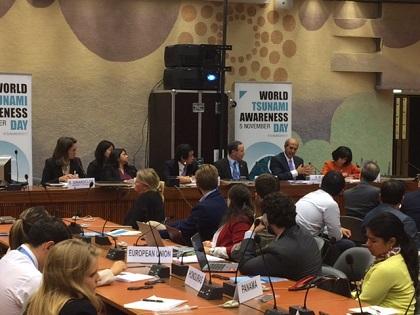
The panel at today's discussion on World Tsunami Awareness Day at the UN in Geneva
By David Singh
GENEVA, 27 October: The build up to World Tsunami Awareness Day on November 5 started in earnest today with a high-level gathering of tsunami-affected countries discussing how to reduce tsunami risk
“In Japan we say be prepared and have no regrets,” said Mr. M. Teru Fukui, Member of Japan’s House of Representatives during the panel discussion today on ‘Reducing the number of disaster affected people’ at the Palais des Nations in Geneva.
Mr. Fukui said, “Since the Great East Japan Earthquake and Tsunami (2011) local governments have been supporting projects for group relocation. Homes which are vulnerable to tsunamis are no longer being built; and maps, evacuation routes, tsunami evacuation towers are being constructed.
“If we deepen the understanding of the next generation about disasters risks, it will help to decrease impact of disasters. Memories can be lost so they must be passed on,” he said.
Mr. Robert Glasser, Special Representative of the United Nations Secretary General for Disaster Risk Reduction said: “A key reason why we mark World Tsunami Awareness Day is that tsunamis have no season. We do not know when or where the next big one will strike but over 11 million people have been affected by tsunamis in the last 25 years, and over 250,000 people have lost their lives.
“The Sendai Framework advocates a multi-hazard approach to disaster risk management. Preparations for a tsunami will stand us in good stead in preparations for floods, storms and earthquakes.”
Mr. Hasan Kleib, Permanent Representative of Indonesia to the United Nation Office at Geneva said that since the 2004 Indian Ocean Tsunami, Indonesia had put a comprehensive tsunami early warning system in place.
“The Rehabilitation and Reconstruction Executing Agency (BRR) for Aceh and Nias, government programmes and coordination of efforts by non-governmental organizations saw towns and villages restored five years after the tsunami. This collaborative mechanism has proved to be effective and is a reference for future responses.”